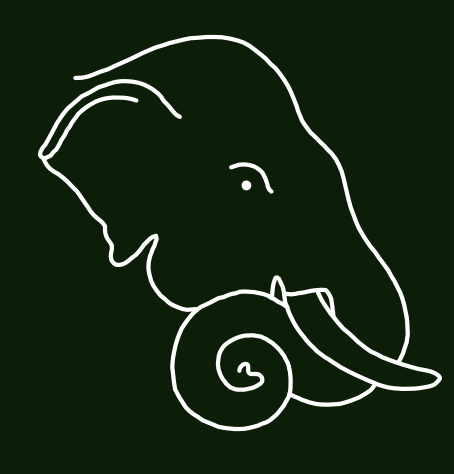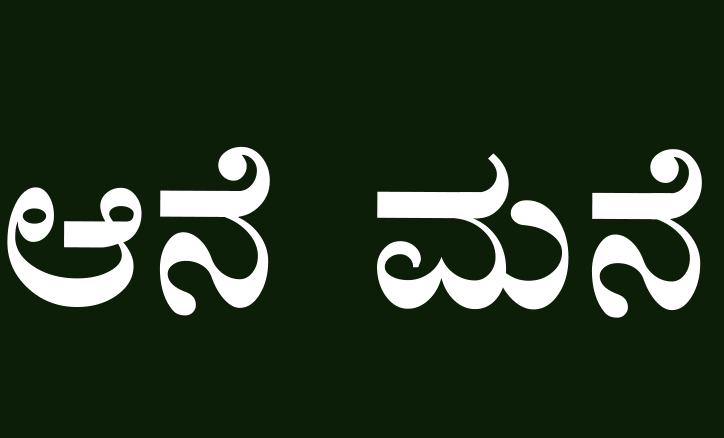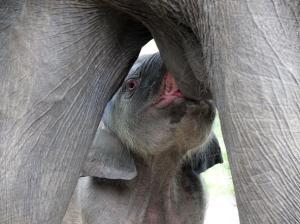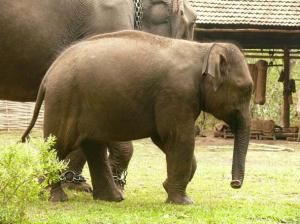


Weaning and training: two distinct processes, by Prajna Chowta

Traditionnally, captive elephant calves are separated from their mothers and weaned at the age of 2 or earlier (sometimes at 6 months !) so that the mother can be put back to work and the calf can be trained and controlled. It is much too early, sometimes fatal for the calf, with deficiencies of the immune system and traumatic consequences for both the calf and its mother. The mother's milk is essential for the growth and the development of the immune system, and suckling certainly has a role in the psychological balance of the animal. In natural conditions, calves suckle up to the age of 6. Experimentations undertaken at Aane Mane's camp with free-ranging elephants in their natural habitat show that there are other ways to handle and vaccinate a calf of 2 or more without having to wean it.
After 18 to 22 months of the gestation period and 2 years caring for the calf, management problems occur, particularly regarding the veterinary care of the calf and comes the time for a process which is the weaning and training of the calf : a delicate subject in terms of animal welfare due to a lack of information on these processes in natural conditions.

1) The general conditions of captivity (space, social interactions, feeding) whether the elephant is free-ranging in its natural habitat, or kept in a forest camp, a zoo or other context and its justifications (work and activities) should first be examined in terms of animal welfare and conservation. (For example, if the mother is alone, she may lack experience in calf care and is deprived of the natural support of other experienced females, which may have negative consequences on her behaviour towards the calf. She also should be helped to prevent possible aggressions from males or other older elephants).
2) The health, growth, behaviour of the calf according to its age should be carefully assessed. (A helpful chart of age and growth parameters is given in the Elephant Code Book)
3) The methods of management and justifications of weaning and training should be scrutinized: (Why should the calf be weaned at this particular moment? Is it really necessary?)
4) Finally, the notions of weaning and training that are usually viewed as one single process should be considered separately.
In fact, when a calf is kept purely for conservation purposes, there is no reason to anticipate the weaning of the animal, while training becomes a necessity for a safe management. Therefore, the experiment that has been undertaken at Aane Mane camp in the case of Dharma was to dissociate the training and weaning of the calf.
At the age of 2 years, an elephant calf weighs around 500 kg (1100 Pounds). The animal is quite powerful already, becomes difficult to handle for the mahouts and vaccination is a complex affair for the safety of the vet, the staff and for the animal itself. In natural conditions, elephant calves are weaned when the mother delivers another calf, that is usually after about 4-5 years, although they may continue to suckle along with the new calf or with a surrogate or allomother, so natural weaning doesn't occur before the age of 6 and is a progressive — not sudden — process.
The decision to separate Dharma temporarily from his mother and allomother at the age of 2 years and 5 months was taken in consideration of the following factors:
Dharma had been suckling both his mother and allomother, which meant a double dose of colostrum and milk. Since birth, the calf was habituated to human contact, voice and hand feeding. The first vaccination at 6 months was undertaken without difficulty. At 1 year, vaccination was impossible without tying the calf as the animal had developed the habit of charging and kicking.
Therefore, a temporary separation was planned for December 2009, just after the monsoon when green fodder is abundant and temperatures are cool.
The mother was taken away, simply coaxed by the mahouts, without the use of koonkie elephants. Then, for 4 weeks, an experienced mahout gave him an elementary training (human contact, voice, hand feeding, bathing and basic commands).
When the mahout had reasonable control over the calf, it was let back to its mother and allomother and after a few days, he resumed suckling. Reuniting mother and calf is contrary to the tradition of elephant training as it might hinder the complete control of man over the animal. For pure conservation, these justifications do not hold anymore. However, there are several reasons why we decided to do otherwise:
1) There are a number of potential predators in the forest (doles, panthers and tigers), so a calf cannot be let alone for grazing in its natural habitat.
2) The mother's milk is always beneficial for the growth of the animal and the development of its immune system. In fact, after a separation of 4 weeks the mother resumed lactating over again.
3) Social interaction with the mother is very important for the development of the animal's behaviour.
Dharma continued to suckle his mother and allomother until they each delivered a new calf about 4 years later, after which they would not let him suckle anymore. Therefore, complete weaning took place when Dharma was 6 years and 4 months old. During these 4 years, the mahouts had a good control over the animal and he could be managed, vaccinated and treated safely.
However, with our following calves, we took further steps in our management principles:
1) The calf is used to human presence and contact from birth for a few minutes per day. We have observed that in natural conditions, a calve attempts to suckle any elephant in the group and is frequently accepted by another female that becomes its allomother, which is a lasting relationship to be preserved.
2) After 6 months, minor gentle training sessions of 15 minutes everyday in the presence of the mother, while she is given her ration: give-and-take play of titbits (fruit or hay and paddy snack); getting used to being touched on all parts of the body; learning how to lift each foot at the request of the mahout, then 2 feet at the same time (side or in diagonal).
3) The calf is never separated from its mother before she delivers another calf or the age of 6 years (whichever occurs first) and only for 4 to 7 days maximum. A training session of 4-7 days is usually enough to control the habit of charging and kicking. This implies learning to sit and lie down on both sides at the request of the mahout, and should be repeated regularly later in the presence of the mother.
4) Females should never be definitively separated from their mother, allomother and sisters as they are meant to remain together during their entire life. Disturbing this bond is detrimental.
5) In natural conditions, male calves are progressively rejected by their mothers and other females of the herd around the age of 10-12 when they begin to demonstrate sexual needs. Therefore, male calves should definitively not be separated from their mothers or allomothers before they reach that stage.
Still, at any age, whether male or female, the calves still learn social behaviour from their mother and other females in the group. Preserving this natural learning process helps in avoiding future behavioural problems and improving the management.
To share your views and experience on the subject, write to us here.
For further information, refer to the Elephant Code Book
© Copyright 2008-2025 Aane Mane Foundation.
All rights reserved. Web design by Lor.